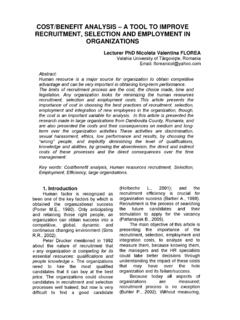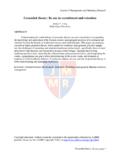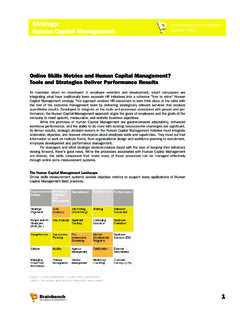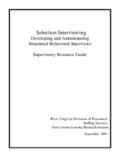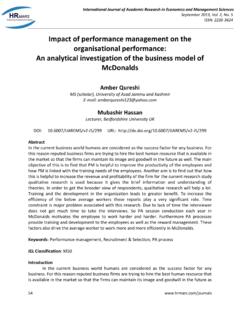Transcription of Recruitment and Selection Process - IJSRP
1 International Journal of Scientific and Research Publications, Volume 5, Issue 4, April 2015 1 ISSN 2250-3153 Recruitment and Selection Process , , 1 & 2 Assistant Professor, Department Of Management Studies 1&2 Engineering College, Nagapattinam-611002, Tamilnadu, SouthIndia. ABSTRACT- Recruitment is the Process of searching for prospective employees and stimulating them to apply for jobs in the organization. Selection may be defined as the Process by which the organization chooses from among the applicants, those people whom they feel would best meet the job requirement, considering current environmental condition.
2 In today's rapidly changing business environment, organizations have to respond quickly to requirements for people. Hence, it is important to have a well-defined Recruitment policy in place, which can be executed effectively to get the best fits for the vacant positions. Selecting the wrong candidate or rejecting the right candidate could turn out to be costly mistakes for the organization. 1. INTRODUCTION In this study helps the organization to identify the area of problem and suggest way to improve the Recruitment and Selection Process , this study focus on understanding Recruitment and Selection Process this study helps to manage a manpower budget for the Recruitment and Selection Process , this study helps to evaluate the time constrain for the Recruitment Process .
3 The study stratified sampling technique is used. The sample size for the study is 100. The tools that are used in this study, One way ANOVA, Chi Square, and Correlation. NEED FOR THE STUDY Determine the present and future requirement of the organization personnel-planning and job analysis activities. Understanding the Recruitment and Selection Process in organization. Analysis of manpower budget analysis of the for the Recruitment in the Recruitment Process . OBJECTIVES To assess the perception of the employers regarding Recruitment Process they have undergone.
4 To identify the average time spent for Selection Process . To identify new ways of improving the present Recruitment procedure. SCOPE OF THE STUDY This study helps to make decision in selecting the right candidates for the right job. This study helps the organization to study the area of problem and suggest ways to improve the Recruitment and Selection Process . This study focus on understanding Recruitment and Selection Process . REVIEW OF LITERATURE Work by Alan Price (2007) Price (2007), in his work Human Resource Management in a Business Context, formally defines Recruitment and Selection as the Process of retrieving and attracting able applications for the purpose of employment.
5 He states that the Process of Recruitment is not a simple Selection Process , while it needs management decision making and broad planning in order to appoint the most appropriate manpower. There existing competition among business enterprises for recruiting the most potential workers in on the pathway towards creating innovations, with management decision making and employers attempting to hire only the best applicants who would be the best fit for the corporate culture and ethics specific to the company (Price 2007). This would reflect the fact that the management would particularly shortlist able candidates who are well equipped with the requirements of the position they are applying for, including team work.
6 Since possessing qualities of being a team player would be essential in any management position International Journal of Scientific and Research Publications, Volume 5, Issue 4, April 2015 2 ISSN 2250-3153 Work by Silzer et al (2010): However, the Process of Recruitment does not cease with application of candidature and Selection of the appropriate candidates, but involves sustaining and retaining the employees that are selected, as stated by Silzer et al. (2010). Work of Silzer et al. (2010) was largely concerned with Talent management, and through their work they were successful in resolving issues like whether or not talent is something one can be born with or is it something that can be acquired through development.
7 According to Silzer et al (2010), that was a core challenge in designing talent systems, facing the organization and among the senior management. The only solution to resolve the concern of attaining efficient talent management was by adopting fully-executable Recruitment techniques. Regardless of a well-drawn practical plan on Recruitment and Selection as well as involvement of highly qualified management team, companies following Recruitment processes may face significant obstacles in implementation. As such, theories of HRM can give insights in the most effective approaches to Recruitment even though companies will have to employ their in house management skills for applying generic theories across particular organizational contexts.
8 Word conducted by Silzer et al (2010) described that the primary objective of successful talent strategies is to create both a case as well as a blueprint for developing the talent strategies within a dynamic and highly intensive economy wherein acquisition, deployment and preservation of human capital-talent that matter,, shapes the competitive advantages and success of many companies. RESEARCH METHODOLOGIES Research is the decision regarding what, where, when, how much, by what means concerning an inquiry or a research study constitute a research design.
9 It can be defined as the arrangement of condition for collection and analysis of data in a manner that aims to combine the relevant to the research purpose to the economy procedure. Research is needed because it facilitate the smooth sailing of the various research operations, thereby making research as efficient as possible yielding maximal information with minimal expenditure of effort, time and money. In fact, research design has a great bearing on the reliability of the results arrived at end as such constitutes the firm foundation of the entire edifice of the research work.
10 There are two types of data. Primary data are those which are collected afresh and for the first time and thus happen to be original in character. Secondary data on the other hand, are those which have already been collected by someone else and which have already being passed through the statistical Process . The methods of collecting primary and secondary data differ since; primary data are to be originally collected, while in the case of secondary data, the nature of data collection work is merely that of compilation. A questionnaire is sent to the persons concerned with the request to answer the question and return the questionnaire.










